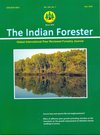Parasitism of Orobanche alba on Thymus serpyllum: A New Report from India
DOI:
https://doi.org/10.36808/if/2016/v142i7/99341Abstract
No Abstract.References
Barina Z. (2009). Orobanche alba subsp. major in Hungary. Studia Bot. Hung., 40: 5–10.
Beck G.B. (1890). Monographie der Gattung Orobanche. Verlag von Theodor Fischer, Cassel. 275 pp.
Dorr I. and Kollmann R. (1995). Symplastic sieve element continuity between Orobanche and its hosts. Acta Botanica, 108: 47–55.
Dorr I. (1996). New results on site-specific bridges between parasites and their hosts. In: Proc. 6th Int. Parasitic Weed Sym. (M.T. Moreno, J.I. Cubero, D. Berner, D. Joel, L.J. Musselman and C. Parker, eds.). Cordoba, Spain. 196–201 pp.
Hassan E., El-Akkad S., Moustafa S. and El-Awadi M. (2004). Histochemical aspects of penetration and vascular connection of broomrape haustoria in the host root, and the possible implication of phenylpropanoids. Int. J. Agri. Biol., 6: 430–434.
Khan M.A., Sharif T., Ahmed M., Zafar M. and Tareen R.B. (2009). Anatomical characterization of parasitic plants of Pakistan. Pak. J. Bot., 41(6): 2661–2669.
Kumar K., Manhas R.K. and Magotra R. (2011). The Shankaracharya sacred grove of Srinagar, Kashmir, India. Current Science, 101(3): 262–263.
Nickrent D.L. (2002). Chapter 3. Phylogentic Origion of Parasitic Plants. In: Parasitic plants of the Iberian Peninsula and Balearic Islands (J.A. Lopez-Saez, P. Catalan and L. Saez, eds.). Mundi-Prensa, Madrid. 29–56 pp.
Parker C. (1986). Scope of agronomic problems caused by Orobanche species. In: Proc. of a Workshop on Biology and Control of Orobanche (S.J. Borg-ter, ed.).Wageningen, The Netherlands. 11–7 pp.
Rosvall A. (1979). Orobanche alba, Timjansnyltrot pa Gotland. Svensk Bot. Tidskr., 73: 1-6.
Rumsey J. and Jury S.L. (1991). An account of Orobanche L. in Britain and Ireland. Watsonia, 18: 257–295.
Schaffer A.A., Jacobsohn R., Joel D.M., Elliasi E. and Fogelman M. (1991). Effect of broomrape (Orobanche spp.) infection on sugar content of carrot roots. Hort. Sci., 26: 892–893.
Silva A. and Rio C. (1996). Effects of the Mistletoe Tristerix aphyllous (Loranthaceae) on the Reproduction of its Cactus host Echinopsis chilensis. Oikos, 75: 437-442.
Sowerby J. (1805). English Botany- ed. 23. London.
Thorogood C.J., Rumsey F.J., Harris S.A. and Hiscock S.J. (2008). Host-driven divergence in the parasitic plant Orobanche minor Sm. (Orobanchaceae). Mol. Ecol., 17: 4289–4303.
Downloads
Downloads
Published
How to Cite
Issue
Section
License
Unless otherwise stated, copyright or similar rights in all materials presented on the site, including graphical images, are owned by Indian Forester.





